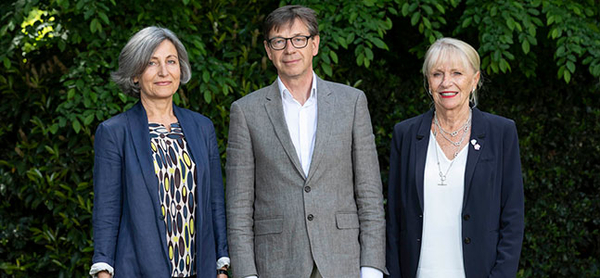No scientist is an island
The first scientific experiment conducted on the Foreword moon and the work of the Nobel laureate Jacques Dubochet have something in common: they are both “Swiss-made”, but neither would have seen the light of day without a good dose of internationality.
In July 1969, just after landing on the moon, Buzz Aldrin planted an aluminium sail to collect the particles carried by the solar wind. This unique experiment was not devised by an American but by researchers in Switzerland, namely Johannes Geiss, Peter Eberhardt and Peter Signer. The fact that two of them knew researchers in the United States and had spent time over there proved instrumental in persuading NASA to support the idea. The decision paid dividends, as the experiment helped to broaden our understanding of the solar system – and burnish the credentials of Swiss research.
Take Jacques Dubochet, for instance. He worked for a long time in Switzerland. But he was awarded the 2017 Nobel Prize in chemistry for his work on electronic cryo-microscopy, conducted... at the European biology laboratory in Heidelberg, Germany. This discovery would not have been possible without other people crossing his path. “My life is about research and collaboration,” he often says.
These examples highlight one of the main reasons for Switzerland’s leading position in the science world: its penchant for working across national borders, for growing through contacts with researchers from abroad and for avoiding insularity. This makes Switzerland a very attractive place for researchers from all over the world: they come here to work in cutting-edge research institutions such as CERN or the PSI, where they also have the opportunity to benefit from SNSF funding.
The SNSF supports Swiss research excellence with a wide range of funding measures designed to promote and facilitate the international integration of the Swiss scientific community (see page7). Some of these schemes are aimed at young researchers. Thanks to mobility fellowships, they can gain valuable experience, and enhance their scientific profile and self-reliance by working at a research institution abroad, as exemplified by the story of Daniel Kienzler on page6. And by participating in European programmes, scientists can compete not only with their peers in Switzerland – which they do by taking part in SNSF selection processes – but also with the best minds in Europe. Moreover, the SNSF actively participates in a number of initiatives and organisations aimed at strengthening scientific collaboration and improving conditions for researchers overall.
That said, Swiss research could never deliver the excellent results that it does without the return of Swiss researchers who have honed their skills in some other part of the world. In this area, too, the SNSF offers relevant funding opportunities.
“No man is an island,” wrote the English metaphysical poet John Donne almost four centuries ago. Let’s dare to paraphrase him: “No scientist is an island, entire of itself; every scientist is a piece of the continent, a part of the main.” Only by being open to the world can researchers keep on improving, till they eventually reach for the moon... or a Nobel Prize, perhaps.



Grazie mille, e buona fortuna
Gabriele Gendotti stepped down as President of the SNSF Foundation Council in 2018 in order to take up his new role as President of the Suva Council. Since 2003, Gabriele Gendotti has been a member of the SNSF Foundation Council, and its President since 2012. His tenure as President spanned two multi-year programmes and included various personnel changes on the upper echelons of the SNSF hierarchy. He also presided over a partial revision of the Statutes and the Funding Regulations. The SNSF would like to thank Gabriele Gendotti for his commitment through all these years, and for his valuable work in the interests of Swiss science. We wish him all success in his new role.
